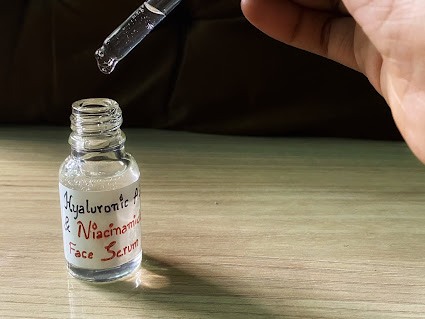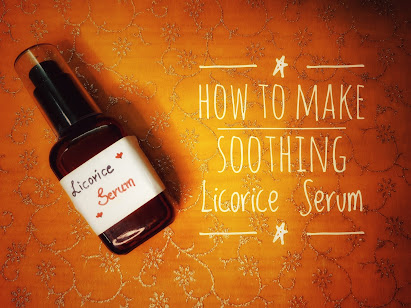The key ingredient in this formulation is SCI (Sodium Cocoyl Isethionate). It is an anionic surfactant, negatively charged which attracts the dirt and oil from the hair and washes away. It is available in different forms like powder, prills and noodles.
It is considered as one of the mildest surfactant and is mostly used in Sydnet bars (Synthetic detergent bars). I have one in my blog too. If you want to read, check here. But, SCI is not widely used in liquid Shampoo because it has stability issues. It crystallizes back after sometime even though it appears dissolved when making it. I know, you also now want to know how to use it in liquid shampoo now. I also felt same few months ago, went through lot of articles and sites, finally I found a discussion in chemist corner which helped me make this one. I will leave the links in the bottom as references. I highly recommend to go through if you have any questions.
So, what are the solutions?
One is to add a non-ionic emulsifier to stabilize the emulsion and prevent from re-crystallization. I haven't worked on it yet but Susan from Swiftcraftmonkey has mentioned about it in her blog. Link would be in references.
Second is to add co-surfactant Coco betaine in ration of 3:1 with SCI (i.e 3 parts of Coco betaine to 1 part of SCI). First, need to heat SCI in water until it melts completely (90 degree C), then add coco betaine after removing from heat at 70 degree C, later add all the remaining ingredients (Check chemistcorner discussion).
I have tried the second method thrice and it was success. Yay! I have used all 3 bottles of Shampoo, it is good.
How does the shampoo feel?
It is mild and doesn't give squeaky clean feel but it rinses hair without any doubt. It has a thin lather which forms suds.
Now coming to other ingredients used and procedure.
Ingredients Used:
1) Coco betaine, amphoteric surfactant to stabilise the formulation and to increase mildness.
2) Sodium Cocoyl Isethionate, ecocert approved anionic surfactant.
3) Sodium Cocoyl Glutamate +amino acid blend, ecocert approved anionic surfactant.
4) Decyl Glucoside, ecocert approved non-ionic surfacant.
5) Xylishine: I personally find a difference in hair texture when Xylishine is added.
6) Euxyl PE 9010: it is an ecocert approved broad spectrum preservative
7) Fragrance oil blend: Baby powder and Rose garden fragrances from Moksha lifestyle. I personally like the combination of these. It smells soft and lovely.
8) Arnica extract: Arnica is known to be a good herb for hair problems. I have used Arnica hair oil before too for dandruff. I thought why not give a try.
How to calculate the total active matter of Shampoo?
I have used 4 surfactants here with different active matter concentration.
1) SCI prills - 84% active
2) Coco betaine - 31% active
3) Sodium Cocyl Glutamate - 35% active
4) Decyl glucoside- 51% active
Typical shampoos contain 10-15% total active concentration. There is no hard rule that it needs to be same. It is recommended one.
What does active concentration mean?
When we say 31% active, rest 69% is water. So when you add 10g of Coco betaine, you are not having 10% active matter since it is diluted. That is the reason why we need to calculate total active matter too.
This shampoo has 15.83% active surfactant matter. How did I calculate that? Check below,
I want to use SCI of 7%, so I will multiply 7 with 84(Active matter of SCI) and divide by 100.
= 7*84/100 = 5.88
Coco betaine is thrice the amount of SCI, so 7*3= 21%, I will multiply 21 with 31 (active matter of coco betaine) and divide by 100.
=21*31/100 = 6.51
I just tested with different percentages of SCG and DG to see if the total active matter is around 15. Finally, arrived at 4% each. Sodium Cococyl Glutamate(SCG) of 4% , so I will multiply 4 with 35% (SCG active matter) and divide by 100.
=4*35/100 = 1.4
Decyl glucoside of 4%, so, I will multiply 4 with 51 (active matter of DG) and divide by 100.
=4*51/100= 2.04
Total surfactant matter = 5.88+6.51+1.4+2.04 = 15.83% active
Now, let's make it without any more delay.
Ingredients and quantities required: (200g batch)
Phase A:
SCI prills- 7% - 14g (Use a mask when measuring it)
Distilled Water 58% - 116g + 11g (extra 10% to top up for the evaporated water loss)
(You can add 116g grams only and add extra water that is evaporated after removing from heat too. That is a better approach)
Phase B:
Coco Betaine - 21% - 42g
Phase C:
Sodium Cocoyl Glutamate and Amino acid blend- 4% - 8g
Decyl Glucoside - 4% - 8g
Phase D:
Xylishine- 2% - 4g
Euxyl pe 9010 - 1% - 2g
Fragrance Oil- 1% - 2g
Arnica extract (W.S) - 2% - 4g
Citric acid solution - as per the pH adjustment
Procedure:
Caution: Use a mask when measuring or pouring SCI because it is so dusty and tiny that it might be breathed and effect your lungs.
1) Heat the Phase A ingredients in a beaker at 90 degree C. My double boiler could only reach till 88 degree C. I would suggest to wait till SCI melts and water reaches it's maximum temperature near to 90 degree C. Put a thermometer inside the beaker to monitor temperature. If you have infrared thermometer, you could use that too, to check the temperature in intervals.
2) Once phase A ingredients are completely melted, remove from heat, wait till it drops to 70 degree C, then add coco betaine and stir slowly without generating lot of bubbles. If in case the bubbles are more, it will reduce in sometime. Don't worry.
3) Add phase C ingredients when coco betaine is mixed.
The shampoo looks transparent as of now but when you add phase D ingredients and citrix acid solution, it will turn into milky color shampoo.
4) You can add phase D ingredients when it comes to room temperature, below 30 degree C.
Stir to mix everything.
5) Add few drops of citric acid solution (30% or 50%), test pH and add accordingly to get the pH near between 5- 5.8
How to check the pH?
It is better to use pH meter instead of strips to test pH .
1) Take 10% of product and 90% of water in a beaker and stir it to mix properly.
Example: 2g of product and 18g of water for 20g test sample (or) 5g of product and 45g of water for 50g test sample.
2) Dip the pH meter in distilled water and wipe with paper towel or cloth.
3) Now, put the pH meter in the test sample and stir it for few seconds and turn on the meter.
4) You will notice the pH value changing.
5) Once the pH value is constant, it can be noted as the pH of end product.
To increase pH, TEA can be added. To decrease pH, diluted citric acid or lactic acid can be added. Whenever adding pH adjusters, do remember to add only few drops at a time since it can drastically change after a point.
Substitutions:
1) Since the main ingredient is SCI, I wouldn't recommend swapping it or coco betaine if you want to make an SCI shampoo.
2) Sodium cocyl glutamate can be substituted with other anionic surfactant which has active matter of 35% . If not, total surfactant active matter needs to be calculated.
3) Decyl Glucoside can be substituted with other non-ionic surfactant like coco glucoside with active matter of 51%. If not, total surfactant active matter needs to be calculated.
4) Xylishine and Arnica extract can be replaced with any other extracts that you prefer. Some good ones for hair are rosemary, cedarwood, clarysage, amla, shikakai, ginger, camphor, fenugreek, vetiver, curry leaf. Usage rates will differ with suppliers.
5) Any other broad spectrum preservative can be used in place of Euxyl PE 9010. If you are using Geogard ECT, it is safe to reduce the pH to 5 since it is most effective at pH 5.
6) Fragrances can of personal choice. Essential oils can also be used at less than 1.5%. If used more, it may need a solubilizer.
Typical usage rates:
SCI: upto 49%
Coco betaine: 4-40%
Sodium Cocoyl Glutamate: upto 15%
Decyl glucoside: 5-40%
Xylishine: upto 3%
Euxyl pe 9010: upto 1%
Reference links:
https://chemistscorner.com/cosmeticsciencetalk/discussion/1927/sodium-cocoyl-isethionate-solubilization-problem
https://chemistscorner.com/cosmeticsciencetalk/discussion/7778/sodium-cocoyl-isethionate-coco-betaine#:~:text=I%20made%20a%20Coco%20Betaine,thick%20white%20paste%20is%20formed.
https://www.swiftcraftymonkey.blog/qa-incorporating-sci-into-a-liquid-shampoo-or-body-wash/
https://citeseerx.ist.psu.edu/viewdoc/download?doi=10.1.1.574.2046&rep=rep1&type=pdf
https://makingskincare.com/surfactant-calculator/
https://itsallinmyhands.com/tag/formulating/





Comments